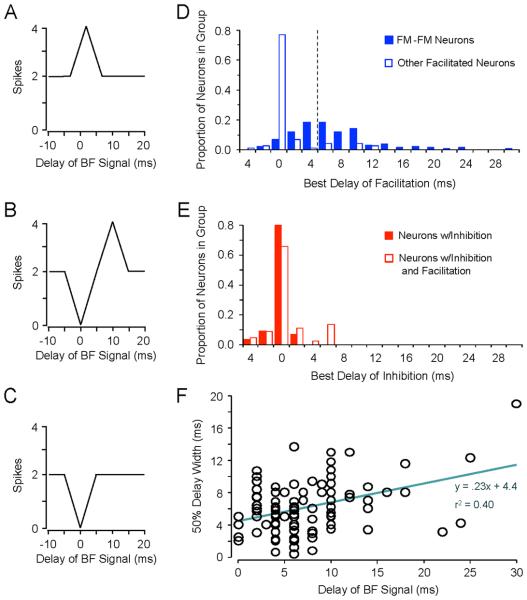Figure 3.
Variation in delay sensitivity among FM-FM neurons in the mustached bat's IC. A. Schematic delay function for FM-FM neuron with only facilitatory responses to combinations of tones in the FM1 and higher harmonic FM frequency bands. The facilitation is tuned to short delays (3 ms best delay) between low-frequency and subsequent high-frequency signals. B. Delay function for FM-FM neuron with both facilitatory and inhibitory responses to combinations. The inhibitory interaction is strongest at 0 ms delay, while the facilitatory interaction is strongest at a longer delay (10 ms). C. Delay function for FM-FM neuron with only an inhibitory influence of signals in FM1 frequency band. Inhibition is strongest at 0 ms delay. D. Best delays of facilitation for FM-FM neurons and other combination-sensitive neurons (including FM-CF, CF/CF, and non-sonar combinations) from the mustached bat's IC. The FM-FM neurons have distinctly different delay tuning. Dashed vertical line indicates approximate separation between facilitated FM-FM neurons without inhibition (having short best delays) and facilitated neurons with inhibition (having long best delays). Data from Leroy and Wenstrup, 2000; Nataraj and Wenstrup, 2005; and Portfors and Wenstrup, 1999. E. Best delays of inhibition for FM-FM neurons that show no facilitation (illustrated in C) and those that also show facilitation (illustrated in B). For both groups, inhibition is strongest at 0 ms delay. Mechanistic studies suggest that inhibition in both groups has a common origin (see Section III). Data from Nataraj and Wenstrup, 2005; Portfors and Wenstrup, 1999. F. Width of delay tuning (50% Delay Width) in FM-FM neurons from IC is weakly correlated with best delay. Data from Nataraj and Wenstrup, 2005; Portfors and Wenstrup, 1999.

